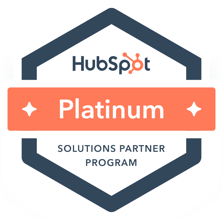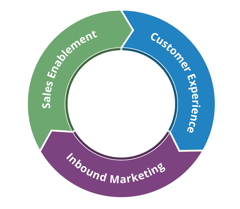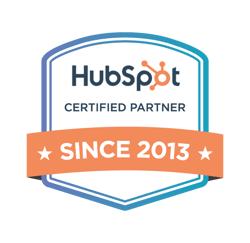 HubSpot is an all-in-one inbound marketing software tool that can allow you to optimize your WordPress website for lead generation and conversion. Site owners use HubSpot to improve traffic generation, lead capture, automated nurturing, and sales conversion. HubSpot has cemented itself as a force to be reckoned with in this space. HubSpot does bundle its content management system (CMS). Still, many marketers don’t realize a HubSpot WordPress integration is possible via a plugin that gives you an easy way to continue using WordPress as your CMS while integrating HubSpot into your site for your inbound marketing efforts.
HubSpot is an all-in-one inbound marketing software tool that can allow you to optimize your WordPress website for lead generation and conversion. Site owners use HubSpot to improve traffic generation, lead capture, automated nurturing, and sales conversion. HubSpot has cemented itself as a force to be reckoned with in this space. HubSpot does bundle its content management system (CMS). Still, many marketers don’t realize a HubSpot WordPress integration is possible via a plugin that gives you an easy way to continue using WordPress as your CMS while integrating HubSpot into your site for your inbound marketing efforts.
What is HubSpot?
HubSpot enhances your WordPress instance to give you the ability to optimize your website to drive quality traffic, lead conversions, customer communications, sales, and increased customer happiness. It’s a full-serve inbound marketing software platform targeted to help you achieve your businesses success.
In this article, we’re going to walk through the four-step inbound marketing framework HubSpot recommends for connecting with your audience at the right place and at the right time during their buying journey.
1. Attracting Visitors to Your Website
The world of the consumer has changed. It’s no longer acceptable to have your brand interrupting individuals while they are in the middle of something completely unrelated to how you can do business together. Outbound marketing, such as television commercials, magazine ads, radio spots, direct mail, etc., is not only interrupting your audience to try to steal their attention, but often, the nature of these mediums is such that you’re not even speaking to the right audience.
Your ideal customers are the ones who are seeking out your site and reading your content. These people (collectively and conceptually known as “buyer personas”) are the folks for whom you need to be creating content. Buyer personas are holistic ideals of what your customers are really like, inside and out. Personas encompass the goals, challenges, pain points, common objections, and personal and demographic information shared among that particular prospect or customer type. Writing content to address these areas draws in your target market and familiarizes them with your brand.
Some of the most essential facets of the inbound marketing methodology to attract the right users to your site are:
- Content Development (Blogging & Premium Content Offers)
- Search Engine Optimization
- Social Media Marketing
2. Converting Website Visitors Into Qualified Leads
Once you’ve attracted website visitors, the next step is to convert them into leads by gathering their contact information. This is where most companies fail to capitalize. Either they don’t have the right content to drive lead generation, or they give away way too much of their premium content without collecting contact details to bring an individual into the funnel.
Contact information is incredibly valuable to the online marketer. For your visitors to provide their contact details, you need to offer them something of value in return. Some examples of premium-level content are eBooks, whitepapers, checklists, webinars, slide decks, videos, and more. Determine what information is relevant to your buyer persona, and start from there. You need one piece of content per persona to start, and then you can begin to build that out by lifecycle stage. Don’t try to do too much at once, though. Just aim to start with 2-3 pieces of content that address the primary motivations of your most key buyer personas.
Some of the most important things to consider when converting visitors into qualified leads include:
- Landing Pages with Forms
- Calls-to-Action
- Effective Email Marketing
3. Closing Leads Into Customers
This is where we turn those qualified website visitors and leads into customers. Closing a lead and converting them into a customer can be a long process in many industries. It typically takes seven to thirteen touches to convert a lead to a sale. So how can you utilize marketing techniques to help close more customers?
The first thing to remember is that you need to continue providing great content to your leads as they are going through their decision-making process. Your leads will be at very different stages in the buying process, so it’s important to identify what stage they are at so you can deliver the right content, at the right place, and at the right time.
Tools to help with your inbound marketing efforts to close more leads into customers are:
- Marketing Automation
- Lead Nurturing
- Dynamic/Smart Website Content
- Sales Alignment & Lead Scoring
- Customer Relationship Management (CRM)
- Marketing Analytics
4. Delighting Customers to Be Promoters of Your Brand
Inbound marketing and inbound selling are about providing remarkable content to your leads and customers. Just because someone has signed a contract with you, or purchased your products, doesn’t mean you can forget about them. That’s the worst thing you can do! Inbound companies continue to engage with, delight, up-sell, and grow their current customer base into happy brand promoters.
Some ideas for delighting are a customer newsletter (based on buyer persona), surveys, inbound customer service tools to help your customer experience, and even a dedicated blog specific to your customer base.
Here are some ways that you can continue to delight your customers:
- Trigger Marketing
- Social Media Monitoring
- Surveys
- Dynamic Content
- Customer Analytics
- Inbound Customer Support
What to Expect
We’ve had several clients use the HubSpot and WordPress integration and have seen tremendous results from connecting their website with their inbound marketing software.
Some of the results include:
- 4x increase in website traffic
- 2x increase in organic website traffic
- 228% increase in social media website traffic
- 140% increase in referral website traffic
- 47% increase in view to lead rate
- 38% increase in landing page conversions
To get HubSpot and WordPress implemented is fairly simple. All you need is the HubSpot tracking code, and you then embed that on your WordPress site and install the HubSpot plugin.
Once You're Setup, What Should You Do Next?
- I recommend adding a call-to-action from HubSpot on each page of your WordPress website. Using the plugin, you will be able to easily see in HubSpot which calls-to-actions are generating the most clicks and leads.
- Replace that with a HubSpot form wherever you’re using a WordPress form. You can do this using the embed code from HubSpot. This will allow you to trigger automation and workflows based on the form submission.
- Set up your email automation in HubSpot based on the above form submissions and conversions on your website. This will allow you to truly maximize the value of the HubSpot and WordPress integration by nurturing your leads as they convert on your website.
- Measure your analytics. With the plugin, you will be able to easily see which channels are not only driving the most visits but, more importantly, the most leads and customers. This is critical to analyzing your inbound marketing strategy daily, weekly, and monthly to make sure you’re optimizing your strategy to coincide with your business's goals.
For one client, before using HubSpot and the WordPress plugin, they could not track conversions on their website, get detailed analytics, including how people were finding their website, and most importantly, get data on how people converted on calls-to-action. Using the WordPress plugin, in conjunction with HubSpot, has allowed them to maximize the value of their website to turn it into a lead generation engine. Since the transition, they have seen their website visits increase by an average of 352% over the first six months, and leads increase by 124% over the first six months.
The HubSpot and WordPress integration can be powerful tools for your inbound marketing efforts. Please remember that the only way to be truly effective is to have a holistic inbound marketing strategy that covers all facets of the inbound methodology. Making a strategic decision to start with inbound marketing will help maximize your online marketing efforts by increasing website visitors, lead generation, customers, and happy customers! Inbound marketing empowers marketers to attract visitors, convert leads, close customers, and delight promoters.
Schedule your inbound marketing consultation if you want to connect with us to discuss your inbound marketing strategy using HubSpot and WordPress.


__Square.png?width=250&height=250&name=Marketing_Hub_(1)__Square.png)




.png?width=250&name=diamond-badge-color%20(1).png)
